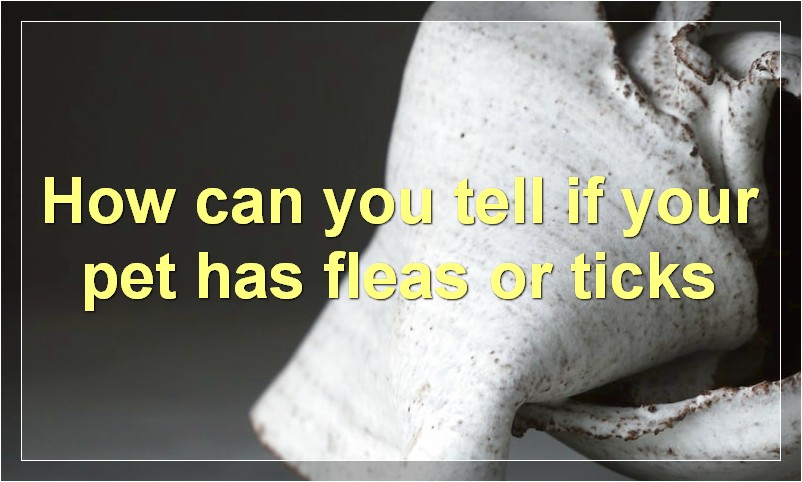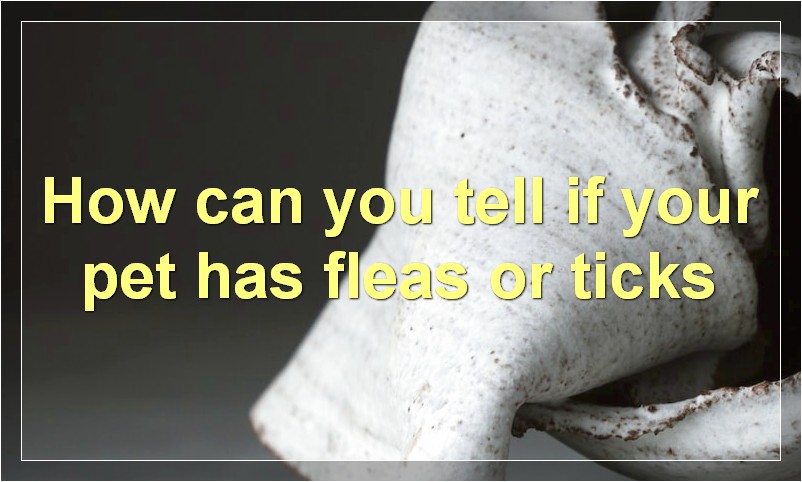There are many differences between fleas and ticks, but the most important difference is how they affect your health. Fleas are not known to transmit any diseases to humans, while ticks are known to transmit diseases like Lyme disease, Rocky Mountain spotted fever, and Ehrlichiosis. So if you’re wondering which is worse for your health, the answer is tick!
How can you tell if your pet has fleas or ticks?

Most pet parents are all too familiar with the itchy misery that fleas and ticks can cause their beloved animals. But how can you tell if your pet has these pesky critters? Here are a few tips:
First, take a close look at your pet’s fur. If you see any small, dark specks that look like dirt, those could be flea droppings. To confirm, wet a cotton swab with alcohol and press it against one of the specks. If it dissolves and turns reddish-brown, that’s a positive sign that your pet has fleas.
Next, check for any signs of irritation around your pet’s neck, ears, and hindquarters. If you see any redness, swelling, or bald spots, those could be indications that your pet has fleas or ticks.
Finally, pay attention to your pet’s behavior. If they’re scratching or biting themselves more than usual, that could be a sign that they’re trying to relieve the itchiness caused by fleas or ticks.
If you suspect that your pet has fleas or ticks, the best course of action is to take them to the vet for a thorough examination. Your vet will be able to confirm whether or not your pet has fleas or ticks and recommend the best treatment options.
How do fleas and ticks differ in their appearance?
Ticks are easy to spot on your pet because they are large, flat, and usually dark in color. They attach themselves to your pet’s skin and feed on their blood. Ticks can cause disease in both animals and humans, so it’s important to remove them as soon as possible.
Fleas are much smaller than ticks and are reddish-brown in color. They live off the blood of animals and can jump great distances. Fleas can also carry diseases, so it’s important to remove them from your pet as soon as possible.
What are the most common signs and symptoms of fleas and ticks?
Fleas and ticks are both common parasites that can infest both humans and animals. Fleas are small, dark-colored, wingless insects that feed on the blood of their host. Ticks are larger than fleas, and have a hard shell that covers their back. Both fleas and ticks can cause itching and irritation, and can transmit diseases to their hosts.
The most common sign of fleas is itching. This is caused by the bites of the fleas, which inject a small amount of saliva into the skin of their host. The saliva contains an anticoagulant, which prevents the blood from clotting. This causes the victim to scratch, which further irritates the skin and can lead to secondary infections. In severe cases, flea bites can cause anemia.
Ticks also bite their hosts, but they do not inject saliva. Instead, they insert their mouthparts into the skin and draw out blood. This can also cause irritation and itching, as well as a feeling of heaviness in the affected limb. Ticks can also transmit diseases to their hosts, including Lyme disease, Rocky Mountain spotted fever, and tularemia.
If you suspect that you or your pet has been infested with fleas or ticks, contact your veterinarian or doctor immediately.
How do fleas and ticks spread?
Fleas and ticks are parasites that feed off the blood of their hosts, which can include both animals and humans. These pests are capable of transmitting diseases to their hosts, which is why it’s important to be aware of how they spread in order to prevent infestations.
There are a number of ways that fleas and ticks can spread, the most common being through contact with an infected animal or person. Fleas and ticks can also spread through contact with contaminated surfaces, such as bedding or furniture, and in some cases, they can be transported by birds or other animals.
The best way to prevent flea and tick infestations is to regularly treat your pets with products that contain insecticides, and to regularly inspect your home for any signs of these pests. If you do find fleas or ticks in your home, it’s important to contact a pest control professional to have them safely removed.
How can you prevent fleas and ticks from infesting your home?

Fleas and ticks are a common problem for many homeowners. These pests can cause a great deal of discomfort for your family and your pets, and can also transmit diseases. There are a number of things you can do to prevent fleas and ticks from infesting your home.
The first step is to keep your yard clean and free of debris. This will make it less attractive to fleas and ticks. You should also mow the lawn regularly to discourage these pests from taking up residence.
If you have any trees or shrubs in your yard, make sure they are trimmed so that fleas and ticks cannot hide in them. You should also remove any dead leaves or branches from the premises.
Another way to prevent fleas and ticks from infesting your home is to treat your pets with a monthly preventative medication. There are a number of different products available, so talk to your veterinarian about which one is right for your pet.
Finally, if you do find fleas or ticks in your home, there are a number of products available to kill them. Be sure to follow the directions carefully to avoid harming yourself or your family.
How can you get rid of fleas and ticks once they’ve infested your home?
If your home has been invaded by fleas or ticks, there are a few things you can do to get rid of them. First, vacuum your floors and upholstered furniture to remove any eggs, larvae, or adult fleas. Then, wash all of your bedding and clothing in hot water. You may also want to treat your pets with a flea or tick preventative to keep them from bringing the pests back into your home. Finally, call a pest control professional to have your home treated for fleas and ticks.
What are some natural remedies for preventing and treating fleas and ticks?
As the weather gets warmer, we start to spend more time outdoors enjoying the sunshine and fresh air. Unfortunately, warmer weather also means an increase in fleas and ticks. These pesky critters can not only be a nuisance, but can also carry disease. Here are some natural remedies for preventing and treating fleas and ticks.
Fleas are small, wingless insects that feed on the blood of mammals and birds. They can jump long distances and reproduce quickly, making them difficult to control. Ticks are larger than fleas and are found in wooded or grassy areas. They attach themselves to their host and feed on their blood. Ticks can also transmit diseases, such as Lyme disease, to humans and animals.
There are a number of natural remedies that can be used to prevent and treat flea and tick infestations. Garlic is a natural repellent for both fleas and ticks. Add garlic to your pet’s food or make a garlic spray by mixing chopped garlic with water. Citrus fruits, such as lemons and oranges, contain limonene, which is a natural flea repellent. You can make a citrus spray by mixing the juice of one lemon or orange with water.
Rosemary, eucalyptus, cedar, and lavender oils are all effective at repelling fleas and ticks. You can make a natural flea collar by soaking a bandana in these oils. Or, add a few drops of oil to your pet’s shampoo before bathing them. Apple cider vinegar is another natural repellent that can be used both externally and internally. Add apple cider vinegar to your pet’s food or water or make a spray by mixing it with water.
If your pet already has fleas or ticks, there are a number of natural treatments that can help get rid of them. Dish soap can be used to kill fleas on contact. Make a flea trap by adding dish soap to a bowl of warm water and placing it near where your pet sleeps. The fleas will be attracted to the warmth and jump into the water, where they will drown.
To remove ticks, firstly ensure you have protective gloves on. Use fine-tipped tweezers to grasp the tick as close to the skin’s surface as possible. Slowly pull the tick straight out from the skin without twisting or jerking motion. After removing the tick, clean the bite area with rubbing alcohol or soap and water. You can also apply a topical antibiotic ointment to the bite site if necessary.
Whilefleasandtickscanbeapain,literally,thereareavarietyofnaturalremediesavailabletocontrolthem.Preventionisthekeytocontrollingfleasandtickssobesuretoprotectyourpetsandyourselfbyusingoneofthesenaturalremedies.
What are some chemical-based products for preventing and treating fleas and ticks?
As the weather gets warmer, we start to see more and more fleas and ticks. These pesky parasites can not only be a nuisance, but can also transmit diseases to both humans and pets. Fortunately, there are a variety of chemical-based products that can help prevent and treat fleas and ticks.
One of the most popular products for preventing fleas and ticks is Frontline Plus. This topical solution contains fipronil and (S)-methoprene, which work together to kill fleas, ticks, and chewing lice. Frontline Plus also prevents eggs and larvae from developing into adults, so it helps break the flea life cycle. Another popular product is Advantix II, which contains imidacloprid and permethrin. This topical solution kills fleas, ticks, flea eggs, and larvae. It also repels mosquitoes, so it’s a great option if you live in an area with a lot of mosquito activity.
There are also a variety of oral medications that can help prevent and treat fleas and ticks. Capstar is an oral tablet that starts working within 30 minutes to kill adult fleas. Sentinel Spectrum is an oral chewable that not only prevents fleas and ticks, but also heartworm disease. NexGard is another oral chewable that kills adult fleas and prevents infestation.
If you’re looking for a natural option, there are also a few essential oils that can help repel fleas and ticks. Lavender oil, eucalyptus oil, and citronella oil are all effective at repelling these pests. You can add a few drops of these oils to your dog’s collar or your own clothing to help keep fleas and ticks away.
No matter what type of product you choose, it’s important to follow the instructions carefully and reapply as needed to maintain protection against fleas and ticks.
Are there any risks associated with using chemical-based products to prevent and treat fleas and ticks?
As the warmer weather approaches, so does the increased risk of our pets coming into contact with fleas and ticks. These tiny pests can cause a lot of discomfort for our furry friends, and can even transmit diseases. Luckily, there are a variety of products on the market that can help prevent and treat these problems. However, many of these products contain chemicals that may be harmful to our pets. In this article, we will take a look at some of the risks associated with using chemical-based products to prevent and treat fleas and ticks.
Flea and tick collars are one of the most common methods of prevention and treatment. These collars usually contain chemicals that are released into the animal’s fur and skin, which then works to kill the fleas and ticks. While this method is generally effective, it can also be very dangerous. The chemicals in the collar can be absorbed into the animal’s bloodstream, which can lead to serious health problems. In some cases, these chemicals have even been known to be lethal.
Spot-on treatments are another popular method of flea and tick prevention. These treatments are applied directly to the animal’s skin, usually between the shoulder blades. The active ingredient in these treatments is then distributed evenly across the body, providing protection against fleas and ticks. While spot-on treatments are generally safe, they can still pose a risk to our pets. If not used correctly, these treatments can cause skin irritation and other health problems.
Oral medications are also available for both flea and tick prevention. These medications work by killing the fleas and ticks that come into contact with your pet. While oral medications are considered to be safe, they can still have some side effects. The most common side effect is vomiting, but diarrhea and lethargy have also been reported. In some rare cases, these medications can even cause liver damage.
As you can see, there are a variety of risks associated with using chemical-based products to prevent and treat fleas and ticks. If you decide to use one of these products, it is important that you follow the directions carefully and watch for any adverse reactions in your pet. If you have any concerns, please consult with your veterinarian before using any type of flea or tick product.




